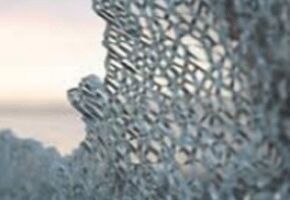
Laminated Glass
Laminated Glass Laminated Glass is made by placing PVB or EVA inter layer films between two or more sheets of annealed/heat strengthened/tempered glass. Under heat and pressure PVB or EVA melts and gets bonded completely with the chemical properties of two or more sheets of glasses making it a single sheet of glass. On breaking the PVB or EVA interlayer films prevent glass from shattering or falling down. The inter layer films PVB or EVA provide excellent protection from uv rays and sound waves. The Laminated Glass is used as safety and security glass for anti burglary, sound proofing. It also Provides protection from uv rays up to 98 -99%. LAMINATION INTERLAYER FILM: EVA Interlayer Film and PVB Interlayer Film are used to make safety laminated glass. PVB stands for Polyvinyl butyral. It is made of polyvinyl alcohol by reaction with butyraldehyde. EVA stands for Ethylene-Vinyl-Acetate GLASS LAMINATED WITH EVA INTERLAYER FILM CAN PROVIDE GREAT SAFETY AND SECURITY FEATURES : EVA is effective for reducing shattering when broken. EVA improves penetration resistance EVA reduces damage levels from natural disasters such as earthquakes, hurricanes and explosions EVA incorporated with PET film shows significant improvement in Anti- burglary properties EVA film owns high-performance safety function properties, it is reliable and produces long-time weather resistance. EVA has Significantly higher Adhesion with Glass and Polycarbonate Under Radiation and Aging tests, EVA is more stable than PVB EVA displays less hydrophilicity as compared to PVB and thus is widely used for outdoor open-edge applications EVA can be combined with other materials to improve the properties and also for decorative purposes. PVB's scope for the same is limited.
...more
Insulated Double Glass Unit
Insulated / Double Glass Unit ( IGU / DGU ): Insulated Glass unit is manufactured using two or three glass panes with an aluminum spacer in between filled with molecular sieves/desiccant creating still air/gas gap between the glasses. The Aluminum Spacer is placed and pasted in between two or there glasses using primary and secondary sealant polysulfide/ butyral and silicon. An Insulated Glass unit blocks transfer of heat as per it's technical parameters from windows etc resulting into decreased load on air conditioning equipments thus saves energy.
...more
Heat Strengthened Glass
Heat Strengthened Glass is produced from annealed glass using lower air quenching pressure. The sudden cooling causes compression on glass surface and the edges and remaining part develops stress zones. For a heat strengthened 6 mm thick glass minimum surface compression is 4000-7000 psi. On breaking the Heat Strengthened Glass breaks in to sharp long pieces. It is twice stronger than the annealed glass. However it can not be used where human safety is concerned until combined with the lamination process of the glass.
...more
Fully Tempered Glass
FULLY TEMPERED GLASS ( TOUGHENED GLASS ): Fully Tempered Glass "popularly known as toughened glass" is made of annealed glass. It is 4 to 5 times stronger than an annealed glass & twice stronger than a heat strengthened glass. The fully tempered glass is heated to its softening point temperature of 600 - 700 degree celsius then it is moved for quenching. The quenching begins at a glass temperature of 400 - 500 degree. The quenching causes compression on 20 percent surface area of glass and edges remaining 60 percent middle part develops stress zones as a result glass becomes stronger on surface and edges providing freedom to applicators for end to end fixing of glass using spider fittings or other accessories used for glass glazing. On breaking a Fully Tempered Glass shatters in to small size oval shaped pieces having blunt edges thus reducing possibility of human injury to a big extent. It is widely used where human safety is concerned. For a fully tempered 6 mm thick glass the minimum surface compression is 10000 psi.
...more
Back Painted Glass
Ceramic Fritted & Back Painted Glass Ceramic Fritting or Back Painting of Glass offers endless options to architects and designers for creative designing by coloring of glass. Ceramic Printing/Painting of Glass is done by using special paint made for glass coloring applications. It is composed of pigments and glass powder applied to glass before tempering by silk screen printing, spraying or roller painting methods. The special paint gets fused with the glass surface during tempering process and the glass develops increased resistance to temperature fluctuations and general weather wear and tear. The ceramic fritted or back painted glasses are used for better appearance, protection from glare and lesser solar factor.
...moreBe first to Rate
Rate ThisOpening Hours